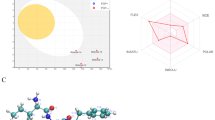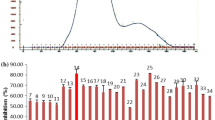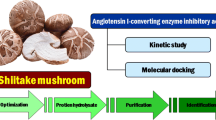Abstract
Angiotensin-I Converting Enzyme (ACE) plays a pivotal role in regulating hypertension. Inhibition of ACE by potent inhibitors is an excellent approach to treating high blood pressure and related cardiac ailments. Dietary proteins are a good source of bioactive peptides with a broad spectrum of pharmacological activities. An attempt has been made in this investigation to study the structure–activity relationship of a novel octapeptide ACE inhibitor having the amino acid sequence: isoleucine-glycine-proline-glycine-proline-phenylalanine-serine-arginine (IGPGPFSR; molecular weight 830.953 Dalton), isolated and identified from Lamellidens marginalis, a freshwater edible Mollusca and still underexploited for its health benefit molecules. The low molecular weight ACE inhibitory peptide has been evaluated for enzyme kinetics, isothermal titration calorimetry (ITC), and site-specific docking simulation study. Lineweaver–Burk plot analysis and ITC reveal that peptide-IGPGPFSR is a non-competitive inhibitor. Molecular docking simulation further confirms that this antihypertensive peptide bound to ACE by hydrogen bond interaction between Asp410, Lys468, His470, Arg479, and Glu104 of the enzyme with Ile1, Pro3, Gly4, Ser7, and Arg8 of the peptide respectively. Interaction of Pro5 and Phe6 of the peptide displaces the zinc (Zn2+) ion from the active site which results in the incapability of the substrate: Hippuryl-L-Histidyl-L-Leucine (HHL) to bind to the active site of the enzyme and ultimately leads to inhibition of ACE. Present observations suggest that this novel antihypertensive octapeptide-IGPGPFSR is a potent inhibitor of ACE and can be used as an auxiliary for nutraceutical therapy against hypertension. Moreover, the underlying mechanism of ACE inhibition will help in widening our knowledge of drug design against enzyme targets.
Graphical Abstract







Similar content being viewed by others
References
Benkert P, Tosatto SCE, Schomburg D (2008) QMEAN: a comprehensive scoring function for model quality assessment. Proteins 71:261–277. https://doi.org/10.1002/prot.21715
Berman HM, Battistuz T, Bhat TN, Bluhm WF, Bourne PE, Burkhardt K et al (2002) The protein data bank. Acta Crystallogr Sect D Biol Crystallogr 58:899–907. https://doi.org/10.1107/S0907444902003451
Bowers KJ (2006) Scalable algorithms for molecular dynamics simulations on commodity clusters. in Proceedings of the 2006 ACM/IEEE Conference on Supercomputing, SC’06 84 (ACM Press, 2006) https://doi.org/10.1145/1188455.1188544.
Ciulli A, Abell C (2005) Biophysical tools to monitor enzyme-ligand interactions of enzymes involved in vitamin biosynthesis. Biochem Soc Trans 33:767. https://doi.org/10.1042/bst0330767
Corvol P, Williams TA (1998) Handbook of Proteolytic Enzymes. Academic, London
Curtis JM, Dennis D, Waddell DS, Macgillivray T, Ewart HS (2002) Determination of angiotensin-converting enzyme inhibitory peptide Leu-Lys-Pro-Asn-Met (LKPNM) in bonito muscle hydrolysates by LC–MS/MS. J Agric Food Chem 50:3919–3925. https://doi.org/10.1021/jf011684c
Dey TK, Chatterjee R, Mandal RS, Roychowdhury A, Paul D, Roy S, Pateiro M, Das AK, Lorenzo JM, Dhar P (2021) ACE inhibitory peptides from Bellamya bengalensis protein hydrolysates: in vitro and in silico molecular assessment. Processes 9:1–13. https://doi.org/10.3390/pr9081316
Dikmen CD, Yucetepe A, Guler FK, Daskaya H, Ozcelik B (2017) Angiotensin-1-converting enzyme (ACE)-inhibitory peptides from plants. Nutrients 9:316. https://doi.org/10.3390/nu9040316
Ferreira SH, Bartelt DC, Greene LJ (1970) Isolation of bradykinin-potentiating peptides from Bothrops jararaca venom. Biochemistry 9:2583–2593. https://doi.org/10.1021/bi00815a005
Friesner RA, Banks JL, Murphy RB, Halgren TA, Klicic JJ, Mainz DT et al (2004) Glide: a new approach for rapid, accurate docking and scoring. 1. Method and assessment of docking accuracy. J Med Chem 47:1739–1749. https://doi.org/10.1021/jm0306430
Haldar A, Das M, Dey TK, Dhar P, Chakrabarti J (2022) Isolation of an antihypertensive bioactive peptide from the freshwater mussel Lamellidens marginalis. Int J Food Nutr Sci 11(1):1–8
He HL, Liu D, Ma CB (2013) Review on the angiotensin-I-converting enzyme (ACE) inhibitor peptides from marine proteins. Appl Biochem Biotechnol 169:738–749. https://doi.org/10.1007/s12010-012-0024-y
Hospital A, Goñi JR, Orozco M, Gelpí JL (2015) Molecular dynamics simulations: advances and applications. Adv Appl Bioinform Chem 8:37–47
Jacob HJ (1999) Physiological genetics: application to hypertension research. Clin Exp Pharm Phys 26:530–535. https://doi.org/10.1046/j.1440-1681.1999.03078.x
Klepeis JL, Larsen KL, Dror RO, Shaw DE (2009) Long-timescale molecular dynamics simulations of protein structure and function. Curr Opin Struct Biol 19:120–127. https://doi.org/10.1016/j.sbi.2009.03.004
Lamiable A, Thevenet P, Rey J, Vavrusa M, Derreumaux P, Tuffery P (2016) PEP-FOLD3: faster de novo structure prediction for linear peptides in solution and in complex. Nucleic Acids Res 44:449–454. https://doi.org/10.1093/nar/gkw329
Laskowski RA, MacArthur MW, Moss SJ, Thornton M (1993) PROCHECK: a program to check the stereochemical quality of protein structures. J Appl Crystallogr 26:283–291. https://doi.org/10.1107/S0021889892009944
Ledesma BH, Recio I, Ramos M, Amigo L (2002) Preparation of ovine and caprine b-lactoglobulin hydrolysates with ACE-inhibitory activity. Identification of active peptides from caprine b-lactoglobulin hydrolysed with thermolysin. Int Dairy J 12:805–812. https://doi.org/10.1016/S0958-6946(02)00080-8
Li GH, Le GW, Shi YH, Shrestha S (2004) Angiotensin I-converting enzyme inhibitory peptides derived from food proteins and their physiological and pharmacological effects. Nutr Res 24:469–486. https://doi.org/10.1016/j.nutres.2003.10.014
Li GH, Qu MR, Wan JZ, You JM (2007) Antihypertensive effect of rice protein hydrolysate with in vitro angiotensin I-converting enzyme inhibitory activity in spontaneously hypertensive rats. Asia Pac J Clin Nutr 16:75. https://doi.org/10.6133/APJCN.2007.16.S1.52
Li H, Ren J, Zhang Z, Chang N, Qin C (2020) Greener liquid phase synthesis and the ACE inhibitory structure-activity relationship of an anti-SARS octapeptide. Org Biomol Chem 18:8433–8442. https://doi.org/10.1039/D0OB01948H
Liang S, ZhengStandley DDM (2011) Fast and accurate prediction of protein side-chain conformations. Bioinformatics 27:2913–2914. https://doi.org/10.1093/bioinformatics/btr482
Murray BA, FitzGerald RJ (2007) Angiotensin converting enzyme inhibitory peptides derived from food proteins: biochemistry bioactivity and production. Curr Pharm Des 13:773–791. https://doi.org/10.2174/138161207780363068
Nakashima Y, Arihara K, Sasaki A, Ishikawa MH, Itoh SM (2002) Antihypertensive activities of peptides derived from porcine skeletal muscle myosin in spontaneously hypertensive rats. J Food Sci 67:434–437. https://doi.org/10.1111/j.1365-2621.2002.tb11424.x
Natesh R, Schwager SLU, Sturrock ED, Acharya KR (2003) Crystal structure of human angiotensin-converting enzyme –lisinopril complex. Nature 421:551–554. https://doi.org/10.1038/nature01370
Natesh R, Schwager SLU, Evans HR, Sturrock ED, Acharya KR (2004) Structural details on the binding of antihypertensive drugs captopril and enalaprilat to human testicular angiotensin I-converting enzyme. Biochemistry 43:8718–8724. https://doi.org/10.1021/bi049480n
Ni H, Li L, Liu G, Hu SQ (2012) Inhibition mechanism and model of an angiotensin 1 converting enzyme (ACE)-inhibitory hexapeptide from yeast (Saccharomyces cerevisiae). PLoS ONE 7(5):1–7. https://doi.org/10.1371/journal.pone.0037077
Nongonierma AB, FitzGerald RJ (2015) The scientific evidence for the role of milk protein-derived bioactive peptides in humans: a Review. J Funct Foods 17:640–656
Prabhakar AK, Roy SP (2009) Ethno-medicinal uses of some shell fishes by people of Kosi River basin of North-Bihar India. Stud Ethno-Med 3(1):1–4
Quiro´s A, Da´valos A, Lasuncio´n MA, Ramos M, Recio I (2008) Bioavailability of the antihypertensive peptide LHLPLP: transepithelial flux of HLPLP. Int Dairy J 18:279–286
Saiga A, Tanabe S, Nishimura T (2003) Antioxidant activity of peptides obtained from porcine myofibrillar proteins by protease treatment. J Agric Food Chem 51(12):3661
Singh H, Singh S, Raghava GPS (2019) Peptide secondary structure prediction using evolutionary information. bioRxiv. https://doi.org/10.1101/558791
Tan J, Tian F, Lv Y, Liu W, Zhong L, Liu Y (2013) Yang L (2013) Integration of QSAR modelling and QM/MM analysis to investigate functional food peptides with antihypertensive activity. Mol Simul. https://doi.org/10.1080/08927022788247
Vermeirssen V, Camp JV, Verstraete W (2004) Bioavailability of angiotensin I converting enzyme inhibitory peptides. Br J Nutr 92:357–366. https://doi.org/10.1079/bjn20041189
Watermeyer JM, Kroger WL, Neill HGO, Sewell BT, Sturrock ED (2008) Probing the basis of domain-dependent inhibition using novel ketone inhibitors of angiotensin-converting enzyme. Biochemistry 47:5942–5950. https://doi.org/10.1021/bi8002605
Webb B, Sali A (2016) Comparative protein structure modeling using MODELLER. Curr Protoc Bioinform. https://doi.org/10.1002/cpbi.3
Wei L, Clauser E, Alhenc-Gelas F, Corvol P (1992) The two homologous domains of human angiotensin I-converting enzyme interact differently with competitive inhibitors. J Biol Chem 267:13398–13405. https://doi.org/10.1016/s0021-9258%2818%2942224-7
Wiederstein M, Sippl MJ (2007) ProSA-web: interactive web service for the recognition of errors in three-dimensional structures of proteins. Nucleic Acids Res 35:407–410. https://doi.org/10.1093/nar/gkm290
Yusuf S, Reddy S, Ounpuu S, Anand S (2001) Global burden of cardiovascular diseases. Part I: general considerations, the epidemiologic transition, risk factors, and impact of urbanization. Circulation 104:2746–2753. https://doi.org/10.1161/hc4601.099487
Acknowledgements
This study was financially supported by the University Grants Commission, New Delhi, India [File No-42-214/2013(SR)].
Author information
Authors and Affiliations
Contributions
Conceptualisation: TKD, PD, JC, Methodology: MD, AH, RC, TKD, Formal analysis and Investigation: MD, AH, RC, AG, TKD, SR, Writing- Original Draft preparation: MD, JC, Writing- Review and editing: MD, PD, JC, Resources: PD, JC, Supervision: PD, JC.
Corresponding author
Ethics declarations
Conflict of interest
There is no conflict of interest to declare.
Ethical Approval
Neither animal nor human studies were conducted by any of the authors.
Additional information
Publisher's Note
Springer Nature remains neutral with regard to jurisdictional claims in published maps and institutional affiliations.
Rights and permissions
Springer Nature or its licensor (e.g. a society or other partner) holds exclusive rights to this article under a publishing agreement with the author(s) or other rightsholder(s); author self-archiving of the accepted manuscript version of this article is solely governed by the terms of such publishing agreement and applicable law.
About this article
Cite this article
Das, M., Halder, A., Chatterjee, R. et al. In Vitro Structure–Activity Relationship Study of a Novel Octapeptide Angiotensin-I Converting Enzyme (ACE) Inhibitor from the Freshwater Mussel Lamellidens marginalis. Int J Pept Res Ther 29, 18 (2023). https://doi.org/10.1007/s10989-023-10495-5
Accepted:
Published:
DOI: https://doi.org/10.1007/s10989-023-10495-5




